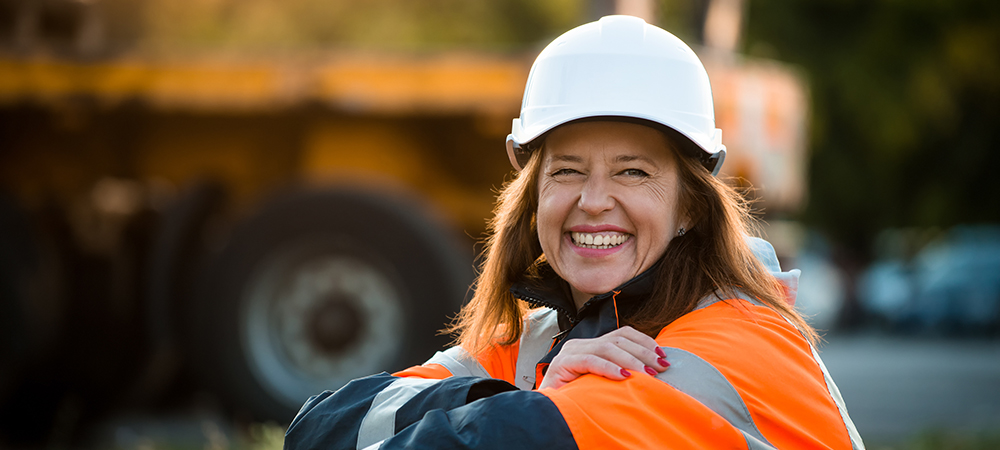Amara Pope, Marketing Manager at Trackunit North America, and North American industry influencers assess the state of play on diversity and where construction goes next.

Legislation in both the US and Canada enshrines the basic principles of equal opportunity to which the vast majority aspire. Gender, race, sexual orientation, age and a whole host of other potentially prejudicial elements to the recruitment process are strictly prohibited.
Despite that, the dice still seem to be firmly loaded in favour of men, especially white, middle-aged men. According to US career experts Zippia in February 2023, there were 767,992 construction workers in the US. Of those, just 6.2% were women.
It seems unlikely that wage differentials are the answer. The same research says women earn 94% of what their male colleagues take home which, while not equal, compares favourably with the gender pay gap across all industries at 82%, according to the Pew Research Center.
Brain, not brawn
In relative terms then, construction should be attractive. And yet the figures demonstrate that it isn’t. That construction sites are loud, dirty, noisy and occasionally dangerous places with a premium still placed on physical power is indisputable, but the growing digitalisation of the industry ought to balance that off as it is opening up a world of opportunity that places much more emphasis on the brain than brawn.
It’s certainly something Maria Boyer, the Vice President of Preconstruction Services at Seattle-based MacDonald Millar, has wrestled with. “Diversity is a journey,” she says. “It’s not the flip of a switch. It’s a hard road, and it’s a commitment that we all have to make to ensure we look like the communities in which we live and in which we serve.”
Indeed, Boyer’s commitment is largely borne out of personal experience having joined the industry in the 1990s and then landing a role as MacDonald Millar’s lone female project manager on construction sites.
Fast forward to 2023 and one of Boyer’s remits at MacDonald Millar is to build and develop the company’s supply and subcontractor diversity programme.
“On the operational side, from a construction management perspective, we have much greater diversity from when I started in the industry over 30 years ago,” says Boyer. “I’m involved in MCA Western Washington where I am a director on the MCAWW board of directors, and I also serve as the chair of their board of education that develops and delivers educational programmes for its members.”
That programme has been in place 24 years and, says Boyer, change has been dramatic. “We’ve seen classes in the early years comprised of all males with a few females, to now seeing nearly a 50/50 split in many of the courses delivered. That shows that our next generation is more diverse, but there are pockets where we have more work to do.”
Indeed, only 8% of women in the US are in management positions and changing this, says Boyer, is critical.
Unconscious bias
“In terms of recruiting, being able to see women and minorities in different positions enables companies and different departments to enforce the old idea that ‘if you can see it, you can be it’,” she says.
“You see less diversity as you go up through the higher ranks and different generations,” adds Boyer. “That is changing ever so slowly. All of those elements are important in moving the needle forward to impact a lasting change of sustained diversity in the construction industry.”
It’s a view that diversity champion Jennifer Todd expanded upon when she spoke to Trackunit. Todd, founder and president of LMS General Contractors, has risen through the ranks of construction over 20 years to become a figurehead for diversity.
“Our perspectives are shaped upon our beliefs, those beliefs stem from our experiences. Leaders at work must be mindful of unconscious bias, or the blinders that we each have,” she says. “We all suffer from unconscious bias at work or blinders that we wear. Due to unconscious bias, workplace culture, as well as who gets hired and promoted, are affected.”
Todd says a proper diversity strategy is fairer, and in the long run, gives businesses a stronger likelihood of success. The US labour market is in short supply and an expected 1 million workers will be required in construction by 2025.
“The labour shortage has impacted all construction trades,” says Todd, who has thrived despite her gender and the colour of her skin. “The infrastructure bill passed, but the industry lacks the infrastructure of people to perform the work. It is impossible to discuss workforce without mentioning DEI (Diversity, Equity & Inclusion).”
Todd advocates tapping into the 140 million-strong Gen Z group and has for that purpose set up the nonprofit ‘A Greener Tomorrow’ offering construction apprenticeships to minorities and women across the US with classroom and on-site training as part of the curriculum. And for those who dismiss this as ‘drop-in-the-ocean’ stuff, A Greener Tomorrow has helped place 85% of its female graduates in construction.
It’s something Boyer also sees where women bring their skills from the classroom or other industries to the table. “There is a lot of transferrable skills,” she says. “That’s how we bridge the gap in some of those other positions that lack diversity in construction.”




